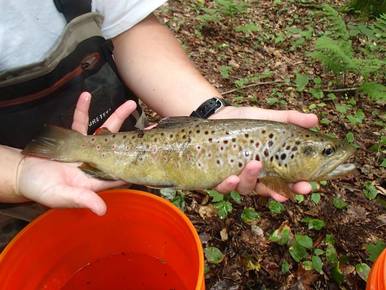 Everything’s fine until the invasives move in. I’ve preached this before. Invasion by nonnative trout results in declines in native trout abundance. On the east coast, I’m talking specifically about invasion of nonnative brown and rainbow trout causing declines to native brook trout. But, what is the mechanism of decline? Is it competition? Sure. Nonnative trout can outcompete native trout for food, habitat, and sometimes even mates (enter tiger trout). Is it habitat preference? Yep, that too. Brown and rainbow trout tend to have higher thermal tolerances, and so they can live in a wider range of habitats. They can also occupy streams with altered flow regimes, higher sedimentation, and lower water quality. What about growth? We have a trifecta- nonnative trout tend to grow faster than natives. This makes nonnatives better competitors, but bigger fish also tend to produce more offspring. So, populations of nonnative trout tend to grow fast and can quickly outnumber native trout (this usually isn’t the case of rainbows in Pennsylvania, but down south rainbow trout populations are taking off and outnumbering brook trout). But, you know what else it could be? Maybe nonnative trout act as a strong selection pressure. This could cause native trout to become maladapted to their local environments because interactions with nonnative fish are acting as a stronger, more acute selection pressure than the environment. Huh? Let’s break this idea down a little. We often think about the environment as the strongest selection pressure that shapes the genetics of populations. And, that’s not wrong. Through hundreds of years of natural selection and adaptation, trout populations have accumulated the genes and outward characteristics that make them best at surviving in coldwater stream habitats. At this point in the evolutionary time scale, the amount of variation in those characteristics is really quite small. Yes, brook trout show a lot of variability, but you can still identify a brook trout from, say, a bass that has spent millions of years evolving for life in a different type of habitat. Almost every brook trout is now well-equipped for life in the typical stream environment. So, now we’re at the stage of fine-tuning the genes in populations. There’s a lot of genes that are good for life in a stream, but only a subset of those are also good for surviving a catastrophic flood. And, only another subset for devastating droughts, or unseasonably hot summers. So, natural selection is still at work. But, it has to wait for these very rare events to occur before there is large shift in the genes in a population. Until then, populations just maintain the characteristics that make them good at life in their streams. But, then life in the stream changes. A nonnative fish invades, and starts imposing a new selection pressure. Suddenly brook trout, which are often the top predator in a small stream, need to compete with another species for food and habitat. And, because presence of the nonnative species is a constant pressure that can act on native species every day and in multiple ways, it starts acting as a stronger selection pressure than rare environmental events. 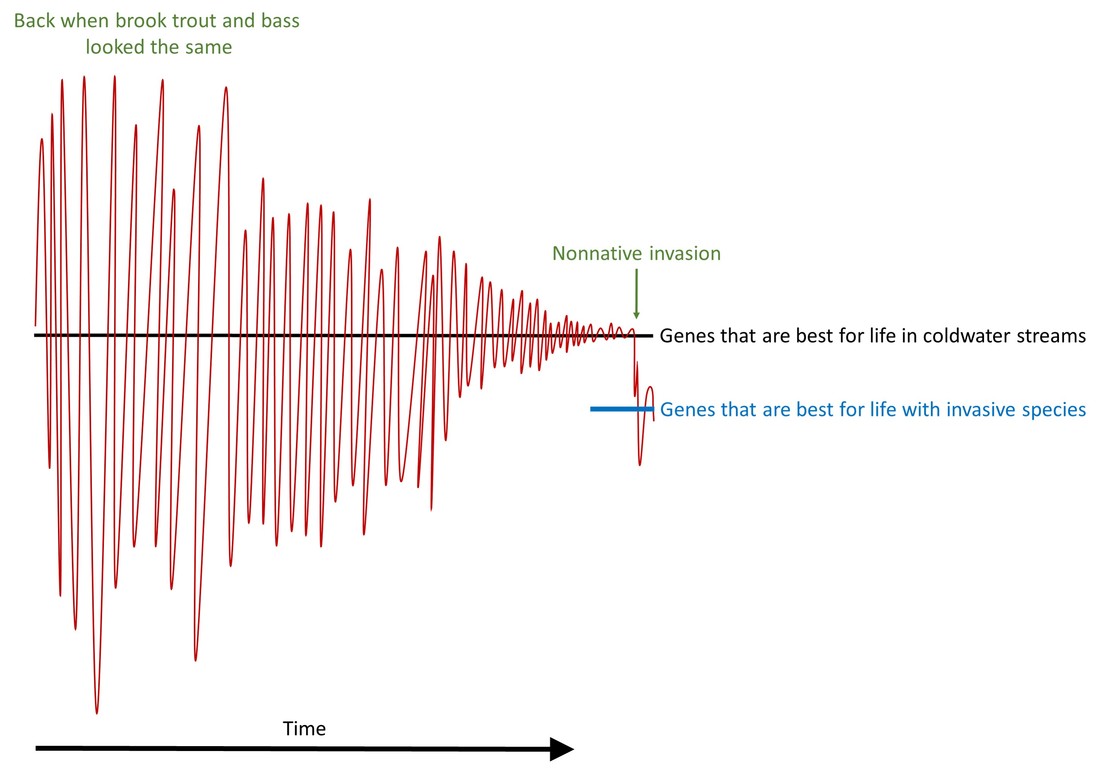 Think of the red line as the genetics in trout populations. Historically, back when fish were new to the animal kingdom, trout and bass probably looked very similar to one another. As evolution occurred, trout genes started becoming more adapted to stream life until there was very little variation in the genes of trout populations (relatively speaking). That was, until the nonnatives moved in.... It may sound a bit far-fetched, but a team of researchers recently completed a study to see if invasive trout could be acting as a selection pressure that overrides selection from the environment. Their work was conducted in Sweden, so in this case the invasive fish was our beloved brook trout, and the native was brown trout. What they found was that, in the presence of nonnative brook trout, brown trout developed stouter bodies, had a smaller home range, and even shifted their diets to consume more terrestrial prey. When brown trout weren’t in the presence of brook trout, they had short daily movements, high metabolic rates, and high activity.
How did brook trout cause this change? It seems to be related to a change in how brown trout live their daily life. When the only top predator, native brown trout can afford to live a high risk, high reward lifestyle. They are free to swim around, eat a lot of the best food (which are often bugs living on the stream bottom), live in the best environments, and defend quality territories from subordinate individuals. To sustain this lifestyle, fish need to have high metabolisms (to keep up with energy needs for swimming and fighting) and body shapes that are more slender, which are better for sustained swimming and foraging. Now, add nonnative brook trout to the mix and brown trout are no longer standing at the top alone. There’s less freedom to move around and find insects on the stream bottom, and so trout switch to a “sit and wait” feeding strategy. Instead of actively foraging, they become drift feeders and wait for terrestrial insects to fall into the stream near them. The addition of brook trout also means there’s generally less food available for each individual, and so slower metabolisms (which require less food to sustain basic biological function) are favored over faster metabolisms. But, slow metabolisms are associated with reduced growth, reproduction, and movement, and so body shape changes and fish develop smaller home ranges. So, the addition of a nonnative trout species results in more than just competition. It can also induce evolutionary change and alter the native species’ behavior, morphology, and physiology. Do these changes then make native species maladapted for everyday stream life? Or, could it reduce survival when there are catastrophic events? How does the presence of a nonnative change the adaptive potential of a native species? I think we need more study to really answer those questions. *Note: Content in this post is my own and may not reflect the opinion of the manuscripts' authors or the agencies they represent. I encourage you to read the manuscript, found here, so you can contribute to the discussion
1 Comment
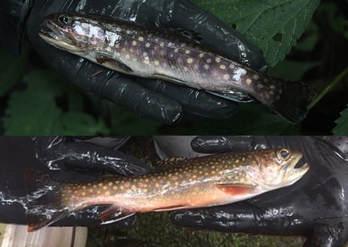 These two fish were caught in the same stream on the same day. Sure the trout on the bottom is larger, but that alone can't explain the differences in color and spot patterning. These two fish were caught in the same stream on the same day. Sure the trout on the bottom is larger, but that alone can't explain the differences in color and spot patterning. I know you’ve done it. You’ve gone fishing in two different streams, or maybe even just looked at photos of brook trout from different areas, and thought “why are these fish so different from one another?” And, I’m not just talking about length. You may have noticed that brook trout can show a very large range in color, patterning, body depth, fin size, etc. Even fish within the same stream can sometimes look completely different. What gives? It’s a great question. And the answers potentially have big implications for our understanding of how trout respond to fragmentation. I’ve already told you that fragmentation results in population isolation, which can lead to loss of genetic diversity and eventually lead to local extirpation. But, there are other changes that can occur before an isolated population collapses- the population size might decline, the ratio of males: females might become skewed, fish may start behaving differently, and, that’s right, individuals may start taking on different physical appearances. The question is whether fragmentation leads to predictable changes in morphology across populations. If so, it indicates that fragmentation could be a factor that influences the evolutionary trajectory of populations in a predictable way. For example, if fragmented populations show a tendency to have reduced body coloration, then we would know that fragmentation somehow operates as a selection pressure, and that bright coloration is somehow not advantageous in fragmented populations (this scenario is purely hypothetical, by the way). So, scientists being scientists, someone went out and tried to determine if fragmentation is an evolutionary selection pressure that acts on brook trout morphology. In a recent paper, researchers from Canada sampled individuals from 14 brook trout populations in Newfoundland, Canada. These populations are all genetically distinct, and upstream of barrier waterfalls (begs the question as to how the brook trout got there. Let’s leave that story for another day, but it was all natural, promise). At each site, the team took measures of body size, weight, and sex. They also took very detailed pictures so that they could later digitally measure things like body color, number of spots, body depth, fin length, hump size, jaw length, etc. Is fragmentation a significant selection pressure on brook trout morphology? Yes and no. The researchers definitely found that populations had very different morphologies. Isolation has prevented gene flow, which has put each population on it’s own evolutionary trajectory. But, population size and standing genetic diversity, which act as a proxy for the strength of the effect of fragmentation, didn’t predict morphology that well. This indicates that fragmentation, itself, isn’t a factor that influences morphological change. Rather, current habitat conditions seemed to have a stronger influence of morphology. Trout in warm, slow streams tended to grow larger and develop a larger hump on their backs (reminder: warm is relative, these populations are in Canada), fish from faster streams tended to have longer pectoral and pelvic fins, and sites with more acidic water had fish with redder color tones.
Interesting, the environmental associations tended to be stronger in females than in males, and females also had more morphological traits that were correlated to habitat. For example, females developed redder tones in deep, fast, warm water, but the association was weaker for males. Why this is the case isn’t entirely clear. But, it likely has something to do with the fact that sexual selection acts much more strongly on males. Sexual selection is a form of natural selection that is specific to traits that increase reproductive success. Think about brook trout spawning behavior, and how sexual selection may act differently on each sex. Females build redds and then wait for eligible bachelors to arrive. Males have to compete for access to females, and subordinate males aren’t going to produce many offspring. This means that natural selection (via sexual selection) is going to strongly favor males that have traits associated with fighting ability during spawning, even if perhaps they are a little less adapted for the environment outside of spawning. Sexual selection acts less strongly on females, and so natural selection is going to favor females that are generally adapted to their local environment. As a result, female morphology is more strongly correlated to habitat than male morphology. So, why do we care about these results as fish managers and conservationists? While many organizations are making strides to increase movement corridors and reconnect populations, streams are still becoming fragmented by loss of thermal habitat, road crossing, dams, etc. The results of this study suggest that fragmentation, itself, doesn’t seem to pose a strong selection pressure. But, the habitat that the fish become isolated in does. By building a road crossing, we could be effectively deciding the morphological fate for brook trout populations. How this could influence population survival remains unclear, but changes in morphology don’t seem, at least right now, to result in rapid loss of population survivability. The more you know… *Note: Content in this post is my own and may not reflect the opinion of the manuscripts' authors or the agencies they represent. I encourage you to read the manuscript, found here, so you can contribute to the discussion. 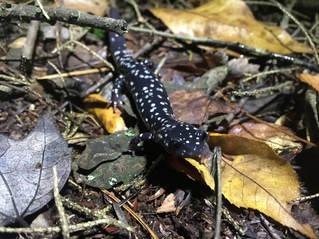 This slimy salamander is not what we were looking for, but exciting nonetheless. This slimy salamander is not what we were looking for, but exciting nonetheless.
One of the best things about graduate school is that there is no shortage of people who are in desperate need of willing (and unwilling) volunteers to help them in the field. Walking in the shoes of another biologist can be a great learning experience. I love my fish, and I won’t be trading them out for another animal anytime soon. But, collecting data on another organism can be more exciting because there are so many unknown about the system. With trout, I already have a standard operating procedure. Not much is surprising, not much is overly exciting. Deer? Bats? Mussels? All new to me.
I’ve been the benefactor of gracious volunteers on many occasions, and so when my friend, David, was going door-to-door asking for help I was quick to jump. It took about ten minutes before I realized what I had just volunteered to do-survey salamanders for 12 hours in cold, wet weather. That doesn’t seem so bad, right? What if I told you that it started at 10pm, and you would be crawling around the forest floor all night long? What was I thinking? Completing and recovering from the survey has probably been the most interesting thing I did this week. So, for today’s post, I’m giving a play-by-play of what happens when the very sleep-motivated fish biologist volunteers on the salamander crew. 4:00am: My normal wake-up call. As I fall out of bed and think about the day ahead, I remember I volunteered to go salamander-ing tonight. Who am I? 11:00am: Wait, what the hell am I going to the forest to look for tonight? A quick chat with another grad student and I’ve got a search image. A red-backed salamander. They joke that I’ll probably confuse frogs, rocks, and sticks with salamanders. They’re probably not wrong. I am no taxonomist. 2:30pm: I leave the office early with intentions to go home, relax, and catch a few hours of sleep before a harsh 9pm wake-up call. Temptation to nap hits around 3:30, but I fight it off. A 20-minute nap now will surely ruin any chances of catching a few solid hours of sleep later. This turns out to be a stupid decision. 6:30pm: Crap. I’m not tired.
8:00pm: Still not tired.
8:10pm: What does one need for a night of salamander-ing? I find snacks and very optimistically pull out my sleeping bag. We’ll be doing one survey at midnight, and another at 6am. Maybe we’ll finish the first survey early and catch a little sleep. 9:00pm: It’s my normal bedtime and I am so very tired. I make a large pot of coffee, pack some away for tomorrow, and drink the other half now. 9:45pm: I leave my apartment to meet the rest of the midnight crew. We travel about an hour to a camp in Bald Eagle State Park. 12:00am: We’ve unloaded the car, prepared all the supplies, and have been given our marching orders. We need to catch 20 salamanders as fast as possible. As soon as we catch one, we place it in a plastic sandwich bag, record the ground temperature, and give it to David who then takes them back to the cabin for processing. We’re dropped off at the site and basically commence a biological word search. Check tree bases, search through leaves, overturn logs and rocks. The salamanders are most active in the middle of the night, so we shouldn’t have too much problem finding them. 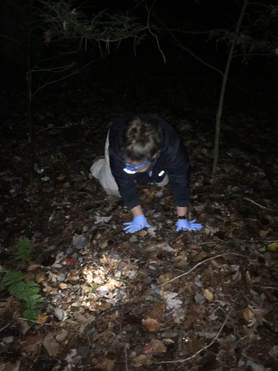 Looking for salamanders in all the wrong places. Looking for salamanders in all the wrong places.
1:00am: We’re having problems finding them. Mostly because the crew is under experienced and has no idea what ideal salamander spots look like. I’ve definitely checked the same tree at least five times, but in the darkness it’s easy to get turned around and have no idea where you are. But, we hit a stride, catch a bunch of salamanders in a row, and things are looking up.
2:15am: We finish catching the salamanders and head back to the cabin thinking that the night is almost over. Ha. Now we have to finish processing them. The objective of the project was to determine how stress hormone levels change throughout the day. As it turns out, collecting stress hormones in a salamander is fairly easy. You simply put the salamander in a jar of water for some amount of time, and then measure the amount of stress hormones in the water. So, back in the cabin, each salamander had been floating in a mason jar for an hour. After time was up, the water was saved in a tube, put in the freezer, and the salamander back in the jar. Now we needed to record length, weight, and sex of each individual, and put them back in their little bag. Shouldn’t take too long, right?
Beating heartbeat from a salamander. Very cool, even when not seen at 3am.
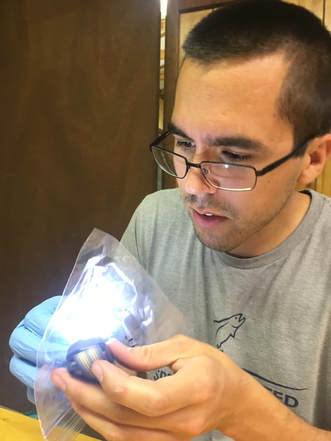 Not only is processing the most tedious part, but you spend most of it looking into bright lights so you can count eggs. I sucked at this part, adding more work for David. (Also, note the trout on David's shirt? See...there are fish in this post!). Not only is processing the most tedious part, but you spend most of it looking into bright lights so you can count eggs. I sucked at this part, adding more work for David. (Also, note the trout on David's shirt? See...there are fish in this post!).
4:00am: It took two hours. The next salamander search starts in two hours, so we try to catch a couple minutes of sleep. But, being as this is my normal wake-up time, I’ve hit a bit of a second wind. Maybe I doze for a few minutes, but I’m actually happy to hear David’s alarm go off at 5:15am to start this all over again. I was getting bored.
6:00am: Salamander search, the sequel. But, now that we know what to do, it goes much faster. The sun is starting to come up, the birds are starting to chirp, but exhaustion is setting in. That thermos of lukewarm coffee has never tasted better. 9:00am: We finish processing the second group, pack up the cabin, release the salamanders back to their homes, and head back to campus. Luckily, we all have meetings on campus that take most of the day, so any thoughts of going home to nap are off the table. 9:00pm: Finally, nearly 41 hours after waking up, I’m home, showered, and in bed. I don’t remember the last time I pulled an all-nighter, but I do know I don’t miss it. So, what lessons did I learn? Night field work is a blast, but I never want to make it a regular event. I’m actually fairly decent at catching salamanders, but really suck at counting their eggs. And, at this stage of my life, it takes several days to recover from an all-nighter. Still working on that. My work on the night crew resulted in an invitation to join the day crew for another survey, this time starting at noon. I suspect that daytime searches are going to be harder, but at least I should get home before sunrise this time. Next week, I promise to get back to the land of trout. Until then, I want to remind you that it is brook trout spawning season, and while the trout are at their prettiest right now, it’s probably not the best time of year to be hitting your favorite watering hole. 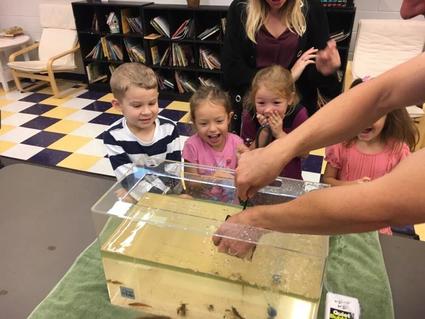 We might have a few budding fish biologists in this photo. We might have a few budding fish biologists in this photo. Now that I’m not in the field these updates are getting a little harder to write. I officially have a “desk job,” and there isn’t much exciting about it on a week-to-week basis. For those of you who are wondering, the introgression manuscript continues to make progress. I’m starting to be a little less stingy with some of the results now that the analysis is complete and I’m confident that the numbers are correct. But, I’m not putting anything into writing until the manuscript has been vetted against all the important people that are above me in the academic food chain. Last week, I did get a chance to get out from behind my computer. But, instead of hitting the streams of Loyalsock, I traded my office chair for a seat in a kindergarten classroom. My advisor, Ty, asked me to help him put on a short demonstration for the kindergarteners at the local elementary school. Having really minimal experience with kids, and a lot of uncertainties about our ability to keep the fish alive and well for a few hours, there was a lot of doubt on how this was going to go off. But, it was a lot of fun. Kindergarteners make the best amateur fish biologists. They still find slimy things cool, aren’t afraid to touch everything, and ask some of the best questions. “Do fish have bones?” “Will it eat my finger?” “What do fish drink?” “Why does it have spines?” “Why is he puffing his cheeks out?” “Why are those lobsters fighting each other?” Okay, so maybe we didn’t explain the ID for crayfish all that well. But, these endless questions reminded me of why I got into science in the first place. I can ask a question about this thing I don’t know much about, and someone will have the answer. And, if they don’t have the answer, I can go find it out for myself. Obviously science gets much complex than kindergarten queries. And, science is down right hard sometimes. Long hours, lots of confusion, lots of times you feel stupid and wrong. But, those hardships only become true burdens when you start asking questions that don’t excite you. It’s easy to hate science when you study something that you, deep down, don’t care to know the answer about. It doesn’t help that the scientific process is sometimes riddled with extraneous steps that can keep you from pursuing your curiosities. So, deep breath. Step back. I’m just out here, trying to ask and answer questions that get me excited. To that end, I’m making a new rule. When my face stops looking like that of the girl’s above- sheer excitement, curiosity, and wonder, I’m quitting. (If you’ve seen me net a large trout, you know I’m nowhere close to quitting.) 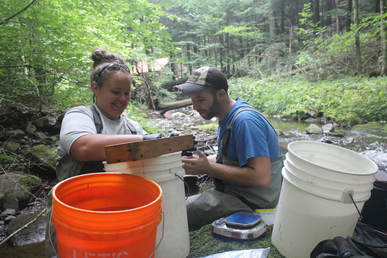 Buckets on buckets on buckets. No matter how many you bring, you always need one more. Buckets on buckets on buckets. No matter how many you bring, you always need one more. We’re so close to submitting our introgression manuscript! This is always one of the most exciting, but also one of the most torturous stages of manuscript preparation. You’re so close to being done (at least until reviews come back), and at this point so tired of working on this one project. But, there are so many tiny little things you have to do before you hit submit- check, recheck, and triple check all your statistics, make sure the format is correct (every journal has their own requirements for what should be bolded, italicized, word counts, etc.), confirm the address of your coauthors, etc. The exciting science is basically over, and now it’s more administrational tasks. This is part of science and graduate school that I never knew about until I started down this path. I still have my fair share of days spent getting my hands wet, holding fish, analyzing data, and being generally confused. You know, all the things I knew science and research entailed. But, there are some jobs, and some parts of jobs, that I never really knew would be part of my career at this stage. So, for all those out there feverously preparing their graduate school applications, or just wondering what it’s like to be an early career fish biologists, here’s the top five things I never knew I’d be doing at this phase of my career.
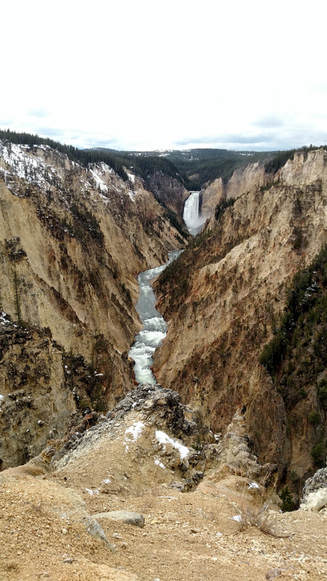 A look down the Grand Canyon of Yellowstone. Looks fake, doesn't it? A look down the Grand Canyon of Yellowstone. Looks fake, doesn't it? Warning: Sappy post ahead Yes, I disappeared again. I’ve been traveling the Rockies- a trip that was initiated by the Wild Trout Symposium in Yellowstone, and then quickly got out of hand when I decided to tack on a few vacation days after realizing how close all of the national parks are. I obviously use the term “close” loosely here, and my bright ideas received further encouragement by my inability to look at the scale bar on a map. But, after nearly 3,000 miles, three national parks (Badlands, Yellowstone, and Grand Tetons), a national memorial (Mount Rushmore), a national monument (Craters of the Moon), and eight states, I am officially working my way back towards home. Very slowly I might add- I’m currently overlooking the sunset over Great Salt Lake from Antelope Island State Park (state park #2, for those counting) before catching the red eye back east. It goes without saying- this was a trip of a lifetime. But, maybe for reasons that aren’t so obvious. Yes, the parks were gorgeous. I’m already planning my trip back. You can’t help but be amazed by the geological and biological wonders of this region. And, I got close enough to pet a bison on multiple occasions (I didn’t…my advisor warned me it would not end well). But, I kind of expected most of that to happen. What I wasn’t expecting was to walk away from the conference so inspired. The Wild Trout Symposium gave new breath at just the time when a PhD student needs it most. Don’t get me wrong, I love my research. I cannot possibly imagine a better project, and there are very few days where I don’t love coming to the office. But, sometimes you get caught in the weeds, especially as you’re trying to string together the analyses, appease reviewers, write papers, and run the rat race of academia. And, while I also enjoy larger meetings (like the American Fisheries Society meeting I attended in August, which always has attendance in the thousands), there is something special about speaking to “your people.” The people who love trout, study trout, and work harder then you to protect and conserve trout. It was interesting to hear about the research advances and conservation challenges that others are facing around the world and across all trout species. It really helped put everything into perspective about the more global significance of the work that is happening in my little corner of the trout world. At the meeting, I also realized more than ever that I’ve grown. A lot. Science education happens very slowly, and there are very few benchmarks for measuring success. You can take tests and get degrees, but those don’t necessarily measure your ability to practice sound science. Soon I’ll be trying to convince my defense committee that I’m worthy of a degree, and the thought of it is panicking- do I really know enough science to deserve a doctorate? Hard to say, and I think the more degrees you get the more you recognize that you’ll always wish you knew more. 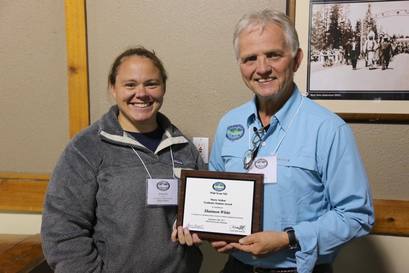 Receiving the Marty Seldon Award from Andy Dolloff. Receiving the Marty Seldon Award from Andy Dolloff. But, I was reminded this week that while I still have (and will always have) a long way to go, I’ve also come a long way. At the meeting, I was honored to win the Marty Seldon Scholarship. The person presenting the award was a member of my Master’s committee, and was almost certainly in attendance the first time I presented at a fish conference. He said the traditional mumbo jumbo- my degree, my school, my project, but then went off script to express how proud he was of the scientist I had become. It meant a lot, and reminded me of the knowledge base (or lack thereof) I had when I first started working in fisheries about 10 years ago. I’d sit in the audience at conferences, having no idea what people were talking about and praying no one asked me questions about my own project. Today, I’m winning awards and serving as a source of advice and knowledge. Crazy. I still, and will forever, have a lot to learn. But, I’ve grown. I’m getting better. Something I’m doing is working. Part of that growth is being able to recognize the significance of a research project. And, there was some great research presented at this meeting. Unfortunately, many of the presentations painted the same dark picture we all know have come to associate with native trout conservation. Habitat is tanking, temperatures are rising, diseases are becoming more common, harvest regulations are inadequate, and hybridization could mean the end to entire species. It would normally be enough to make a trout lover walk away extremely disheartened and hopeless. But, I didn’t. I walked away more confident about the future of trout populations that I had been before because I realized that there are some amazing people in this field. It’s a group of biologist that work tirelessly and are making some great advances in the ecology of wild trout management. We’re moving away from the emphasis on stocking and towards a more holistic approach to conservation. Everything from genetics to metapopulations, habitat improvements to angler satisfaction. It all needs to considered to get the harmonious balance needed to have a chance of conserving wild trout. And, the group gets that. The next hard step that many people identified was now getting all of that science into the hands of managers, anglers, and citizen scientists. We can’t keep managing our resources in ways that we know defy science, but we also can’t change our management when the science is unknown or untrusted. So, my only criticism of that meeting was that I wish you, the angler group that I think comprises the majority of my readership, could have bene there. I think one of the missing pieces of the puzzle at this meeting, but also in general management, is the union between scientists and the public. We’re living in separate bubbles to a large extent, and until we close those gaps we’ll continue to struggle to find the happy balance. Nothing is new on that front, but it’s more justification for why things like this blog and other outreach initiatives are so vital. Even in a perfect world, I don’t expect the fight for native trout to ever get easy. I think one of the lines that echo in my mind was from a presentation from the Yellowstone National Park Superintendent. He talked about their efforts to restore populations of Yellowstone cutthroat trout, which are declining due to habitat loss and invasion by nonnative fishes. At the end, he mentioned some of the hurdles associated with Yellowstone cutthroat trout conservation, and overwhelmingly he noted that he never dreamed that the fight for wild trout conservation would be met with so much resistance. If Yellowstone struggles to restore wild trout, how will all the tiny streams with brook trout possibly fair? I’m not sure, but I have no doubt that we’ll keep putting up a good fight. Exhaustion has set in, and I’m now sitting in terminal A of the Salt Lake City Airport awaiting my midnight boarding call. I’m tired, I’m behind on work, but my head is clear and drive is restored. Wild Trout XII was a success. Sorry, folks. I'm copping out this week. I'm on the heels of another conference, and the there's a tornado of activity as I try to wrap up loose ends at the office before embarking on an eight-state, 12-day tour of the mid-west. Badlands, Rushmore, Bozeman...quick conference in Yellowstone....Jackson Hole, Salt Lake. I live the silver spoon grad school life. In all seriousness, my advisor is more than generous with his allocation of resources and supports me making these trips. Not all advisors give their students the freedom to attend expensive conferences. But, I also help my cause and do some of my own fundraising. A few days ago I was honored to be named a recipient of the 2017 Marty Seldon Scholarship to offset some travel costs to the Wild Trout Symposium in Yellowstone. The application was fairly straightforward- an essay describing my research, involvement in professional fisheries organizations, and what I feel are the most pressing issues in trout conservation. Below is my submission. For many of you seasoned readers, you already know the spiel. For some of you newer readers- sit back, learn a little about me, my research, and what I'm fighting for. Conservation of wild trout populations is met with a myriad of challenges with none more pervasive than climate change. Look no further than the northern-receding margins of the eastern brook trout’s range, collapse of cutthroat trout populations in the Rockies, and declines of European brown trout to find evidence that climate change is threatening salmonids worldwide.
Managing coldwater fisheries under climate change is a complex problem of scale. Large-scale changes to stream temperature, flow regimes, and habitat availability transcend watershed and political boundaries, often making management logistically and financially unfeasible. Yet, there are also small-scale changes to species interactions, population vital rates, and individual fish physiologies that are not only difficult to manage, but also remain poorly understood. Together, the effect that climate change has on trout populations within and across scales produces unanticipated, nonlinear patterns and dynamics that reduce our ability to predict future outcomes of habitat loss and effectively manage trout populations. The efficacy of present-day management objectives, which largely focus on increasing population sizes and habitat availability, will only continue to decline as climate change outpaces restoration efforts. Accordingly, management must become more forward thinking and include conservation of the fine-scale properties that naturally increase population resistance and resilience to habitat loss. To accomplish this goal, a better understanding of individual variation is needed to answer questions such as: why are some populations and individuals more fit than others, are there specific genes that lead to higher thermal tolerance, why do fish behave differently from one another, and is individual variation important for population survival? These are just some of the questions I am addressing in my dissertation research at Pennsylvania State University in the lab of Dr. Tyler Wagner. Specifically, I am merging the fields of genetics, behavior, and population ecology in a series of field and laboratory studies to investigate the adaptive significance of intraspecific variation in native brook trout populations in Pennsylvania. At a molecular level, I am studying population genetic structure to identify spatial patterns in genetic diversity. While previous studies suggest that brook trout populations readily isolate at small spatial scales, my research suggests that genetic connectivity and diversity remain high near mainstem river corridors as compared to headwater populations. This suggests that the processes that maintain metapopulation dynamics differ across the species’ range. Further, because genetic diversity is correlated to adaptive capacity and resiliency, the location of a population within a stream network could predict evolutionary potential and extinction risk. I am also completing one of the first studies of gene expression in wild trout populations to quantify expression patterns of heat shock protein 47 (HSP47), a common indicator of thermal stress in fishes. In total, I evaluated gene expression for nearly 700 fish using non-lethal gill and blood samples collected every 1-3 months for over a year. Preliminary results suggest that HSP47 expression is highest in early spring, and nearly absent in summer when stream temperature is warmest. This suggests that brook trout begin expressing heat shock proteins in response to mild increases in stream temperature, and that there is a limit to how much HSP47 can be produced before gene expression stops. Ultimately, these results could indicate a limited scope for adaptation and plasticity in stress protein production. To determine how intraspecific genetic and behavioral variation influence population structure and survival, I completed a multi-season telemetry study on 180 wild brook trout distributed across four tributaries to Loyalsock Creek, Pennsylvania. From this work, I documented significant individual variation in behavior, including some fish that completed large-scale, post-spawn movements to overwinter in mainstem Loyalsock Creek; a system largely considered unsuitable for brook trout prior to my study. Taken together, the observed zero-centered leptokurtic distribution in movement and patterns in population genetics describe above suggest there may be multiple life history strategies in some brook trout populations, including some highly migratory individuals that disproportionately increase genetic connectivity among populations. In the future, I will complete a genome-wide association study to identify specific genes that correlate to different movement patterns. In the lab, I am completing several studies to determine whether inter-individual differences in behavior can be explained by fish personality. While it is understood that personality can modulate growth, reproduction, and mortality, the ecological and evolutionary significance of personality has not been rigorously explored in any taxa. I determined that boldness, the most studied personality trait in fish, reduces spatial learning ability. This finding suggests that phenotype influences learning and memory processes, and could explain differences in habitat use and movement among individual trout. I am currently conducting another lab study to determine how boldness influences the ability of fish to compete for resources at different stream temperatures. I hypothesize that the higher metabolic demand of bold fish will decrease their success at defending resources at higher temperatures. Though I hope to increase the efficacy of trout management with novel research objectives, I am equally passionate about improving conservation through communication. I am the first author of seven peer-reviewed manuscripts ranging in topics from long-term stream habitat management to social learning in trout. I have also given over 20 presentations at state and national conferences, many of which receiving best paper awards. In addition to professional communication, I continually seek opportunities to interact with the public through outreach and education. I am particularly passionate about introducing prospective biologists to stream ecology within the framework of professional service. For example, my election to President (Virginia Tech Chapter), Membership Chair (Virginia Chapter), and Social Media Coordinator (National Chapter) of AFS has afforded me the opportunity to lead educational programs and workshops for students and professionals and increase AFS participation at all levels. I also served as the Southern Division AFS Newsletter Editor that represents 15 states and am currently a member of the Virginia AFS Outreach Committee. My leadership in AFS has been recognized with several state and national awards. Having realized my passion for science communication, I extended my outreach efforts beyond AFS programs and founded www.thetroutlook.com, a website specifically devoted to improving public access and understanding to information related to coldwater stream and trout ecology. Through weekly updates, I provide information about my research and introduce the readership to topical issues in fisheries conservation. This website has been viewed over 70,000 (side note- this number is getting closer to 100,000 now) times by an international audience, is regularly used as a teaching tool in K-12 schools, and has attracted attention from community groups and universities. Because of this media presence, within the last year I was invited to give nearly 20 seminars to several universities and to the Pennsylvania Council and local chapters of Trout Unlimited. My passions for research, outreach, and education underlie my desire to pursue a career in academia. I believe that the persistence of natural resources will depend on inspired, well-trained scientists who can think creatively and critically to solve some of the world’s most pressing problems. I want to enable the next generation of problem solvers by fostering in them a life-long curiosity for ecological research. This is a goal I have already started realizing as the lead advisor for seven undergraduate students at Penn State and Susquehanna universities completing independent research projects or internships. 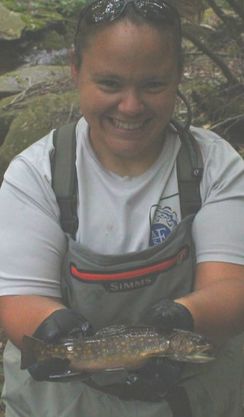 In the end, I think we all want the same thing. Sustainable, safe, and healthy populations of very large brook trout. In the end, I think we all want the same thing. Sustainable, safe, and healthy populations of very large brook trout. I may be too stubborn to stop wearing shorts, but there’s no question that summer has ended in Pennsylvania. Tomorrow I’ll be headed to Loyalsock for my first day of fall sampling, and the third-to-last sampling event of my PhD (crazy). It’s been one wild ride, and the last day I drive out of Loyalsock is going to be a bittersweet exit. But, I have a few months before I need to think about that. What’s on my mind today is the feedback that I’ve gotten from my post last week on stocking. Great discussions, great questions, and hopefully a few people that thought twice about their positions on trout stocking. Generally speaking, the vibe I get from most people is that they do support stocking programs, just not in Class-A wild trout streams. Some even go as far as to advocate for the end of stocking in all streams that support wild trout, regardless of abundance. There’s nothing wrong with these views. In fact, my own opinions are casted with shades of this logic. They present a compromise- potentially a stocking protocol that could allow for increased recreational opportunities while still protecting wild trout. Notice I say “potentially”? In ecology, everything is connected. And, when we do one thing to one stream, we can’t be certain that it will or won’t impact the streams around it. That’s what makes natural resource management a game of knowledge and know-how, but sometimes also a lot of luck. Mother Nature can be finicky. We can do math, study the science, and prescribe a certain management protocol and get the same result 99 times. And then the 100th time it fails. Hopefully it’s a contained failure with minimal loss, but other times the damage cascades throughout the ecosystem causing damage at levels. Not often, but sometimes. So, we can limit stocking. We can even put a moratorium on stocking Class-A streams, or any other stream that holds a special designation. But, how much damage control does that really do? Seriously, I’m asking- I don’t know the answer. The uncertainty comes from the fact that fish move. A lot. Particularly large, stocked fish that are spooked by their new surroundings when they are plopped down into a stream for the first time. In our dataset, we found evidence of hatchery introgression and fish straight off the hatchery truck at sites that are several miles from the closest stocking location. And, we routinely find a pulse of very large fish moving into smaller tributaries in June- the same time when water temperatures in larger waters get too warm. I can’t say that these are definitely hatchery fish, but I would bet money on it (and on a grad student salary, that says a lot). So, my post today is just a cautionary tale. To protect and conserve waters, we can’t keep thinking of streams as individual units. Effective restoration of one stream often requires action to be taken on surrounding streams and on the landscape. Likewise, the effects of stocking will extend beyond the streams that fish are put in. Not stocking Class-A streams would be a great success for native trout conservation. But, if there is a stocking location in the next adjacent tributary, then the successes could still be minimal. As long as we are stocking trout somewhere, there will still be some chance for negative effects to native populations. That isn’t meant to be a rally call for the end to hatcheries. It’s meant to be a warning that the solution isn’t quite as easy as “stock here, not there.” How far hatchery fish can spread is not certain, and it is going to vary depending on a lot of factors. When determining stocking locations, we need to think beyond the immediate radius of the release location. We need to consider what streams are within a few hundreds yards, to maybe even as far as a few miles. Could those stream be influenced by hatchery trout? This brings up a bigger point, and that is nature is too variable for a “one size fits all” approach to management. It’s probably not advisable to advocate for a single management strategy to be deployed across an state. We need more emphasis on adaptive management- on adjusting management protocols in response to changing demands from humans, shifts in climate, and loss or gain of habitat. We need to use all the data available to us and make decisions. If we suspect that a certain management action is threatening trout populations, then it needs to be looked at a little closer and sooner rather than later. It’s a daunting task, and certainly easier said than done. But, aren’t our natural resources worth it?
I’m back! And, boy was my absence untimely. While I enjoyed soaking up the rays attending the annual meeting of the American Fisheries Society in Florida, I unfortunately missed the Pennsylvania Wild Trout Summit. The PA Fish and Boat Commission was quick to post presentations online, so I’ve been able to catch a few talks (including the one below by my advisor, Ty). But, I’ve also been reading some feedback from a few attendees and my takeaway is that the best talk wasn’t by a platform presenter- it was among members in the audience. One of the reasons I love studying trout is the passionate anglers and citizen scientists that are invested and devoted to wild trout conservation and restoration. There is no other angler base that is as informative and fun to interact with as you all, and I was sad to miss the opportunity.
My other observation is that there was some disappointment in what wasn’t discussed. Most notably, it seems a lot of people in attendance wanted to discuss the state’s trout stocking plans. I’m not surprised. Stocking is controversial and there will probably never be a stocking plan that makes everyone happy. But, I’m also encouraged. The public is trying to voice their opinions on this really complex problem, and, from what I’ve seen, seem to largely understand the delicate balance between the science of native fish conservation and the social dynamics of recreational fishing. It’s not an easy line to walk.
I’m also encouraged because it means there is interest in our current research beyond the scientific community. Our manuscript on native and hatchery fish interbreeding is nearing completion, and the results are getting closer to being released. Until then, I’ve been spending most of my days pouring over manuscripts published over the last 20+ years from other studies of hatchery-wild interbreeding and trying to summarize their findings. From this, I’ve already summarized the pros and cons to hatchery stocking, but I’ve left you in limbo the last two weeks. Overall, do hatcheries have more of a positive or negative effect on wild trout populations? Before I answer that question, there are two caveats. First, I’m only discussing recreational stocking- or stocking done to temporarily increase population sizes to allow for increased angling opportunities. The potential pros and cons to conservation stocking are a bit different. Second, I am only focusing on the hard science. I’m not going to attempt to compare the social benefits of stocking with the impacts to native fish diversity. But, you should. Everyone should weigh the pros and cons and make their own informed decisions about stocking. It’s not my place to make the decision for you, but it is my job to present the science so that you can be informed. We know that stocking increases recreational opportunities and can be an economically profitable business, both of which valuable. Taking that into consideration, I have drawn a line in my mind where I think stocking is worthwhile and where it’s not. You need to find that line without someone telling you where they think you should put it. So, after 20+ years of study, what do we know about the effect of hatchery stocking on wild trout populations?
So, where does that leave us? With a lot of uncertainty. Hatcheries can have negative effects on wild populations. But, not always. And, hatchery interbreeding can be high in stocked populations. But, not always. And, we know that there are long-term negative consequences of interbreeding. But, yet again, not always. We just don’t know. Perhaps a more important question- where does that leave you in your thoughts on stocking? 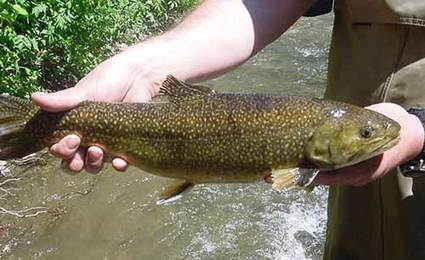 A nearly 18-inch stocked brook trout. What kind of havoc can these guys cause? Photo courtesy of PA Fish and Boat Commission. A nearly 18-inch stocked brook trout. What kind of havoc can these guys cause? Photo courtesy of PA Fish and Boat Commission. Picking up where we left off last week, this week I’m going to flip the switch and talk about the potential negative consequences of stocking. I highly recommend that those who missed, or maybe just don’t remember, last week’s post start there before continuing. Some lingo and concepts may be a little fuzzy without the background information. You didn’t press the back button, did you? (I don’t blame you, I wouldn’t either). So, here’s a quick refresher: wild trout populations have genes that are locally adapted to their native environments. This means that trout have genes that make them successful at life in their home stream, but their genes may not be great for surviving in another stream. However, not all fish in a stream can be identical clones of one another. There needs to be some level of genetic diversity in order for populations to survive disturbance and be able to adapt to future conditions. I call this the “eggs in many baskets” insurance policy. The genes that are best this year may not be the genes that are best next year, and so there needs to be high diversity so that at least some fish can survive and reproduce if conditions change in the future (if you’re a financial guru, this concept is very similar to having a diversified stock portfolio). Easy, right? Well, here’s some of the ways that hatcheries can disrupt this balance. I’m focusing specifically on recreational stocking programs because conservation stocking programs have taken more precautions to avoid these potential pitfalls (though, they do sometimes still happen).
|
AuthorShannon White Archives
October 2018
Categories
All
|
The Troutlook
A brook trout Blog
Proudly powered by Weebly
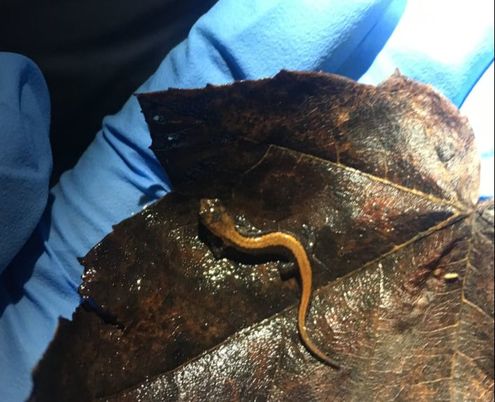
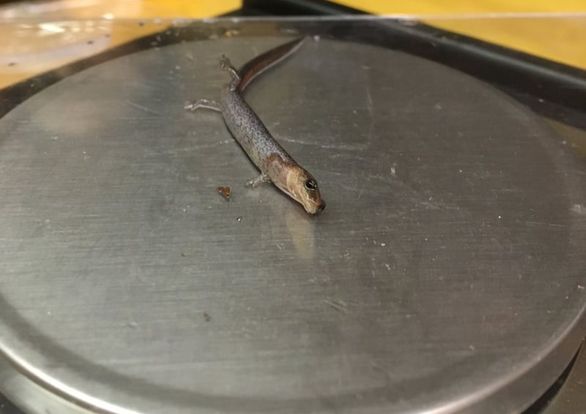
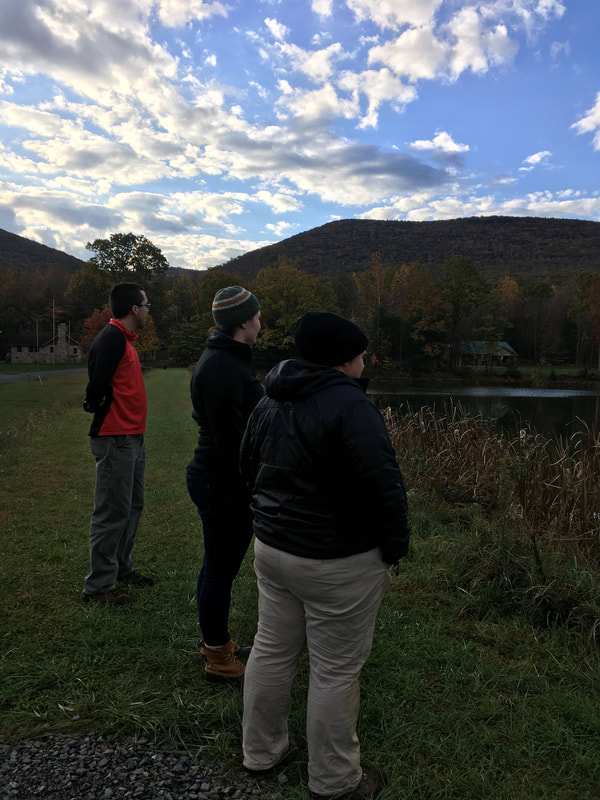
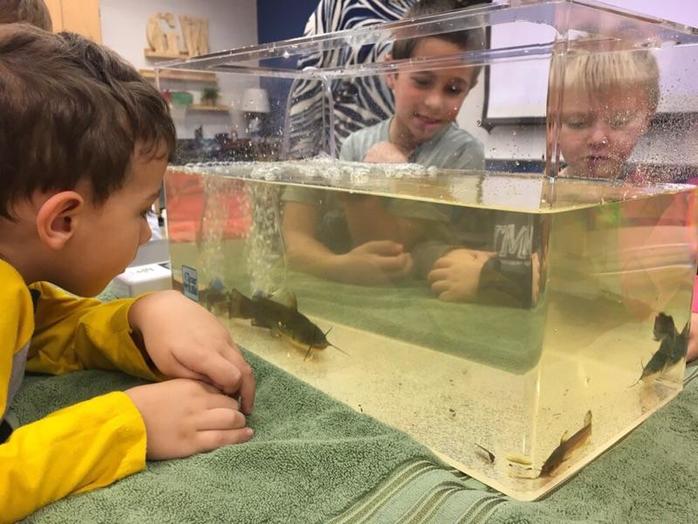
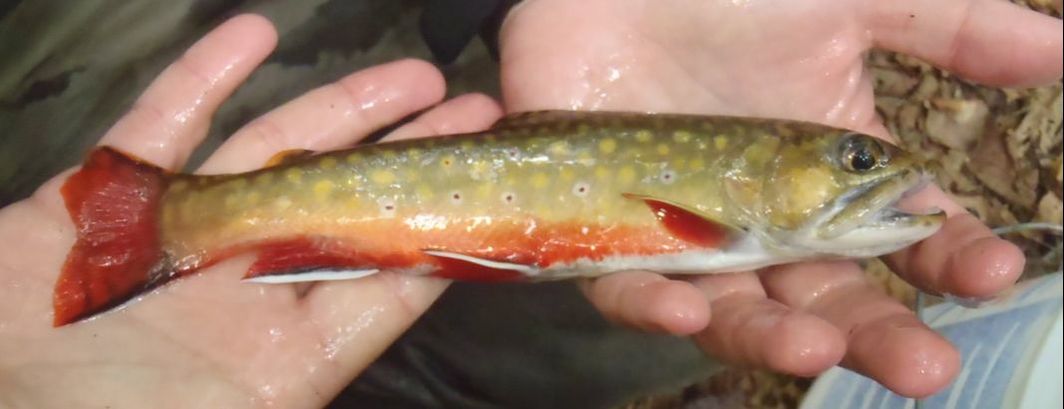
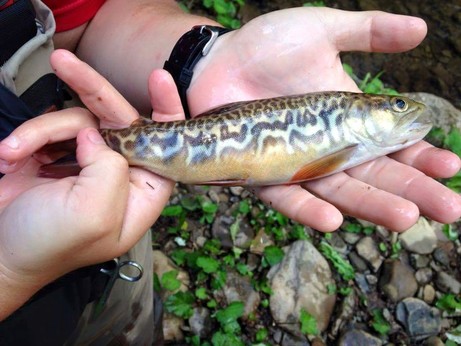
 RSS Feed
RSS Feed